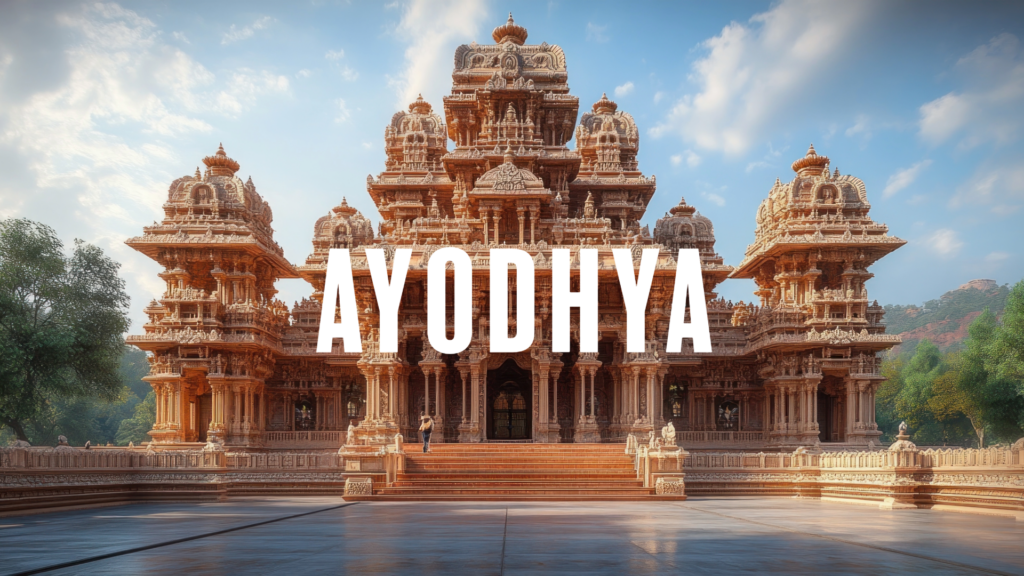Ayodhya, the sacred city on the banks of the Saryu River, is one of India’s most revered pilgrimage destinations. Known as the birthplace of Lord Ram, this ancient city offers a soulful blend of mythology, history, architecture, and devotion.
If you’re planning a trip to this divine city, here’s a curated list of the Top 10 Ayodhya Sightseeing Places that will make your journey truly unforgettable.
1. Sri Ram Janmbhoomi: The Spiritual Heart of Ayodhya
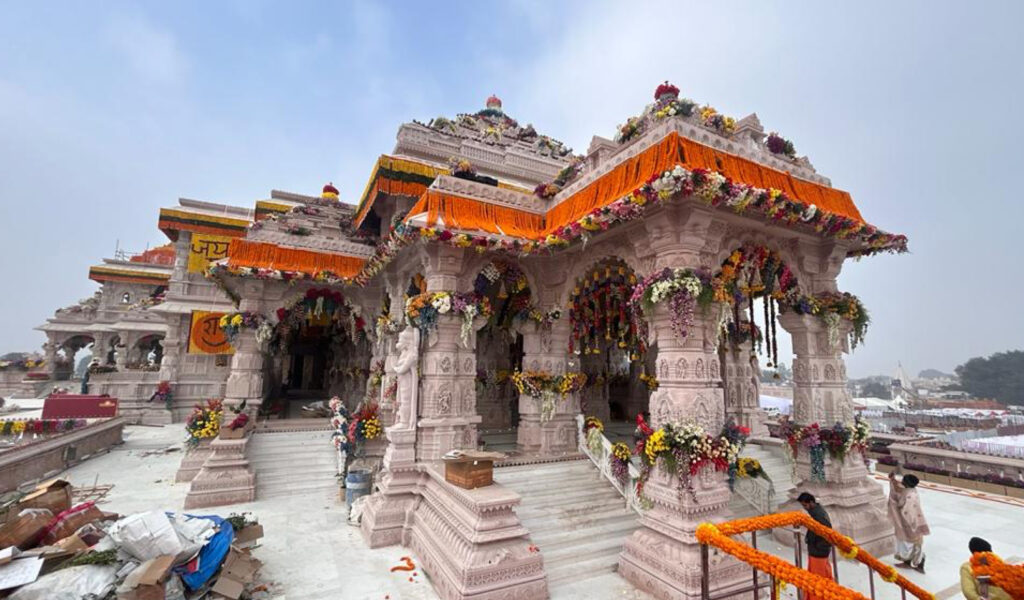
Sri Ram Janmbhoomi is not just the most revered site in Ayodhya—it is the epicenter of devotion, culture, and national heritage. Believed to be the exact birthplace of Lord Ram, this sacred location has been a beacon of faith for countless generations. Among the top Ayodhya sightseeing places, it stands as a powerful symbol of spiritual and cultural identity.
Today, it is home to the under-construction Ram Mandir, a monumental temple that showcases traditional Indian architecture with intricate stone carvings and towering spires. Once completed, it will be one of the largest temples in the world—drawing pilgrims, tourists, and spiritual seekers from across the globe.
What to Expect as a Traveler:
- Spiritual Energy: The atmosphere is filled with chanting, bells, and deep devotion—making it a powerful spiritual experience.
- Historical Significance: You can learn about the site’s ancient history and its role in the Ramayana through local guides and museum exhibits nearby.
- Architectural Marvel: Even in its ongoing phase, the Ram Mandir’s craftsmanship is breathtaking. A full visit can be both meditative and enriching.
- Darshan & Rituals: Participate in or witness the daily aartis and special prayers, especially during Ram Navami, Diwali, and Makar Sankranti.
Travel Tips:
- Security is tight—mobile phones, bags, and electronics are usually not allowed inside the temple premises.
- Wear modest and comfortable clothing.
- Visit early morning or around evening aarti for a more peaceful darshan.
- Local guides are available outside the temple for context and stories (choose authorized ones).
- Shops, rest areas, and prasad counters are available nearby.
How to Reach Sri Ram Janmbhoomi:
By Train:
- Ayodhya Railway Station is the closest (approx. 2 km from the temple).
- Alternatively, Faizabad Junction (Ayodhya Cantt) is around 7–8 km away.
From either station, autos and e-rickshaws are easily available.
By Air:
- Ayodhya International Airport (Maharishi Valmiki Airport) is now operational and located around 10–12 km from the temple.
- Lucknow Airport is the nearest major airport (approx. 130 km), with taxis and buses available to Ayodhya.
By Road:
- Well-connected by road to Lucknow, Varanasi, Prayagraj, and Gorakhpur.
- Regular buses and taxis are available, or you can book a private cab for a more comfortable trip
From City Center:
If you’re staying in Ayodhya, a short auto-rickshaw or cab ride can take you directly to the main entry gate.
2. Hanuman Garhi: The Guardian Temple of Ayodhya
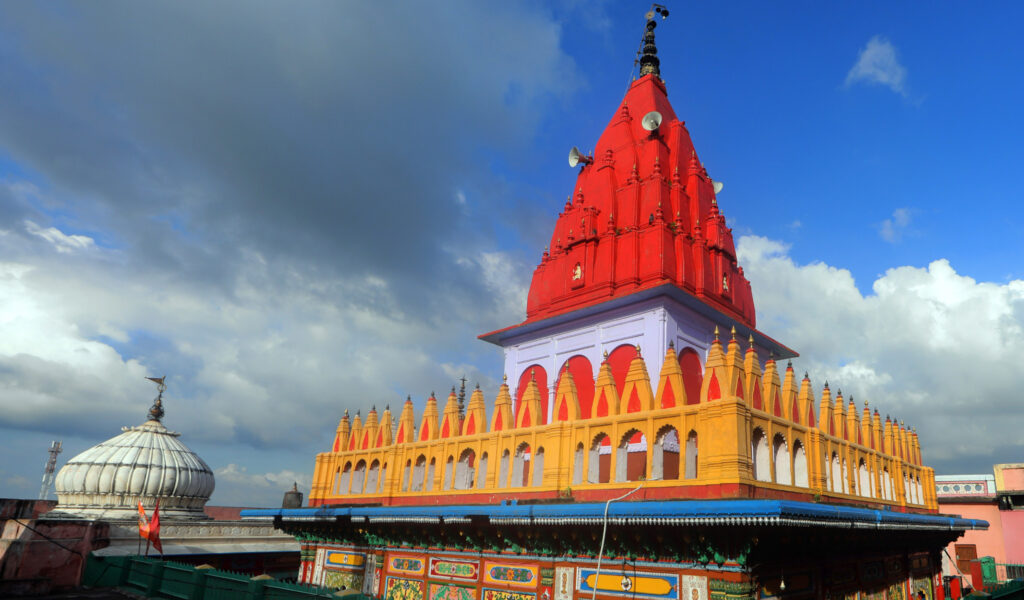
One of the most iconic and widely visited temples in Ayodhya, Hanuman Garhi is dedicated to Lord Hanuman, the mighty devotee of Lord Ram. The temple is believed to protect the entire city of Ayodhya, and pilgrims traditionally visit Hanuman Garhi before heading to Ram Janmbhoomi. It is one of the most prominent Ayodhya sightseeing places, drawing devotees and tourists alike.
Situated atop a small hill, the temple is accessed by climbing 76 steps. Inside, the main sanctum houses a beautiful idol of Lord Hanuman in a sitting posture, with a child form of Lord Ram on his lap—symbolizing protection, devotion, and strength.
What to Expect as a Traveler:
- Spiritual Rituals: The temple is always bustling with chants, bell sounds, and devotees offering sweets, garlands, and oil.
- Panoramic Views: Being slightly elevated, Hanuman Garhi offers a stunning view of the surrounding cityscape.
- Cultural Richness: The temple is a hub of devotion during festivals like Hanuman Jayanti and Ram Navami, when thousands gather to offer prayers.
Travel Tips:
- Footwear is not allowed beyond the entrance—leave it at designated stands.
- Beware of monkeys near the temple—avoid carrying open food or plastic bags.
- Early mornings and evenings are ideal for peaceful visits.
- Combine your visit with nearby attractions like Kanak Bhawan and Dashrath Mahal, which are within walking distance.
How to Reach Hanuman Garhi:
By Train:
- Just 2 km from Ayodhya Railway Station, autos and e-rickshaws are readily available.
- Around 7–8 km from Faizabad Junction (Ayodhya Cantt).
By Air:
- Ayodhya International Airport is approx. 10–12 km away.
- Lucknow Airport is around 130 km; you can take a taxi or bus to Ayodhya.
By Road:
- Direct access via road from all major cities.
- Local transportation is easily available within Ayodhya.
On Foot:
If you’re staying in central Ayodhya, Hanuman Garhi is walkable from several guesthouses and hotels.
3. Kanak Bhawan: The Golden Palace of Sita and Ram
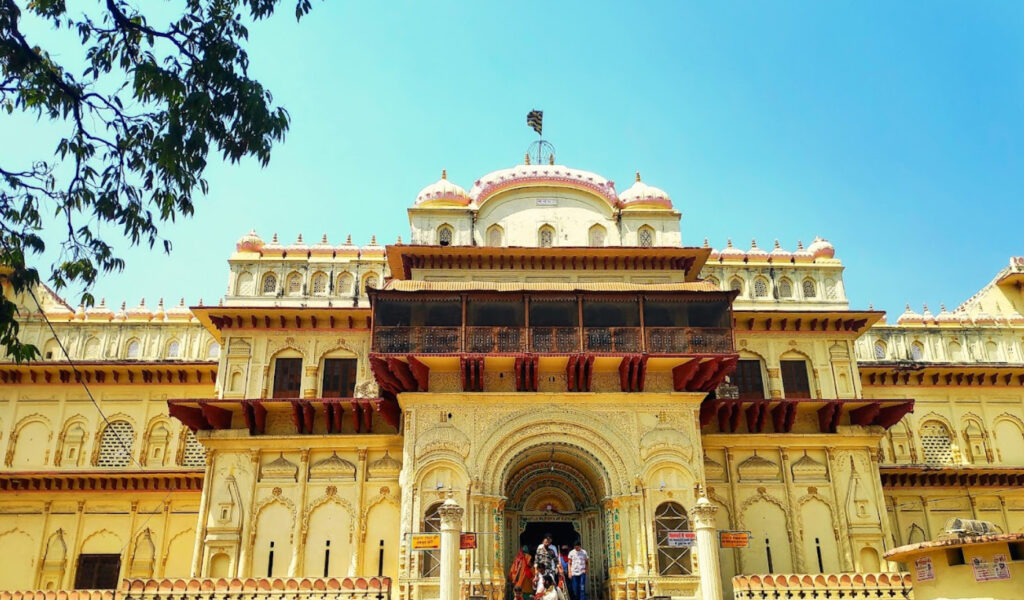
Kanak Bhawan is one of the most beautiful and cherished temples in Ayodhya. Known as the “Golden Palace”, it is believed to have been gifted to Goddess Sita by Queen Kaikeyi after her wedding to Lord Ram. Unlike other temples in the city, Kanak Bhawan has a more palatial architecture, with colorful interiors, vibrant wall paintings, and richly adorned idols of Lord Ram and Sita.
The temple exudes love and peace, making it a must-visit among Ayodhya sightseeing places for both spiritual seekers and art lovers. It stands out as one of the most unique Ayodhya sightseeing places, blending devotion with royal elegance.
What to Expect as a Traveler:
- Divine Idols: The central shrine houses stunning gold-crowned idols of Ram and Sita in regal attire, surrounded by intricate decorations.
- Vibrant Architecture: The temple’s walls and ceilings are adorned with bright, traditional paintings depicting scenes from the Ramayan.
- Quiet Atmosphere: Compared to other major temples, Kanak Bhawan is peaceful and ideal for reflection and personal prayer.
Travel Tips:
- Photography is allowed outside but restricted inside the sanctum.
- Spend a few moments sitting inside to take in the divine ambience.
- Visit during early morning or sunset hours for a calm, devotional experience.
- Combine with a walk to Hanuman Garhi and Dashrath Mahal, both nearby.
How to Reach Kanak Bhawan:
By Train:
- Just 2 km from Ayodhya Railway Station
- About 7–8 km from Faizabad Junction (Ayodhya Cantt)
By Air:
- Ayodhya International Airport is around 10–12 km away.
- Lucknow Airport is approx. 130 km with regular taxi and bus options.
By Road:
- Kanak Bhawan is easily accessible via local autos and rickshaws from any part of Ayodhya.
On Foot:
- Located just a few minutes from Hanuman Garhi. You can comfortably walk between these key attractions.
4. Dashrath Mahal: The Royal Legacy of Lord Ram

Located in the heart of Ayodhya, Dashrath Mahal is believed to have been the palace of King Dashrath, father of Lord Ram. This vibrant and historically rich palace gives a glimpse into the royal life of the Ramayan era. Today, it functions as both a spiritual site and a heritage monument. Today, it functions as both a spiritual site and a heritage monument, and is considered one of the notable Ayodhya sightseeing places.
The palace houses beautifully decorated idols of Lord Ram, Sita, Lakshman, and Bharat. It is a popular stop for pilgrims and travelers looking to connect with the legacy of Ayodhya’s ancient rulers.
What to Expect:
- Royal-style entrance gates and colorful walls
- A peaceful courtyard where rituals and bhajans are often performed
- Chance to interact with resident priests and saints for spiritual insights
Travel Tips:
- Entry is free and usually not very crowded
- Great for photography and heritage lovers
- Pair your visit with Kanak Bhawan and Hanuman Garhi (all in close proximity)
How to Reach:
- Just 2 km from Ayodhya Railway Station
- 10–12 km from Ayodhya International Airport
- Easily accessible via autos or walking from nearby temples
5. Gupt Hari Ghat (Guptar Ghat): Where Lord Ram Took Samadhi
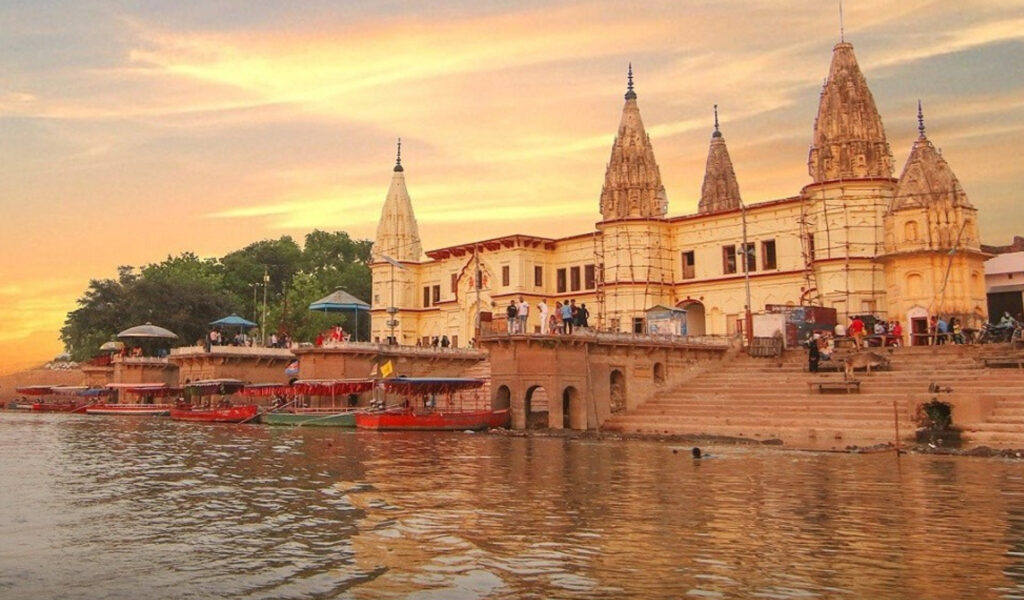
Gupt Hari Ghat, also known as Guptar Ghat, is a tranquil spot along the Saryu River and holds deep mythological significance. It is believed to be the place where Lord Ram took Jal Samadhi after completing his earthly mission.
Today, the ghat is a serene place ideal for spiritual reflection, morning walks, and peaceful boat rides. The evening Saryu Aarti held here is a divine experience, attracting locals and tourists alike.
What to Expect:
- Calm waters and clean riverfront steps
- Boat rides available throughout the day
- Aarti rituals at sunrise and sunset
- Small temples like Chhoti Devkali and Chhoti Chhoti Ramayan Shrines nearby
Travel Tips:
- Best visited early morning or just before sunset
- Wear comfortable footwear as you’ll walk near the ghats
- Great for quiet photography or devotional music recording
How to Reach:
- 5 km from Ayodhya city center
- Accessible by auto-rickshaws or taxis
- Part of many city tour routes—ask your guide to include it
6. Surya Kund: A Sacred Pool of Solar Worship
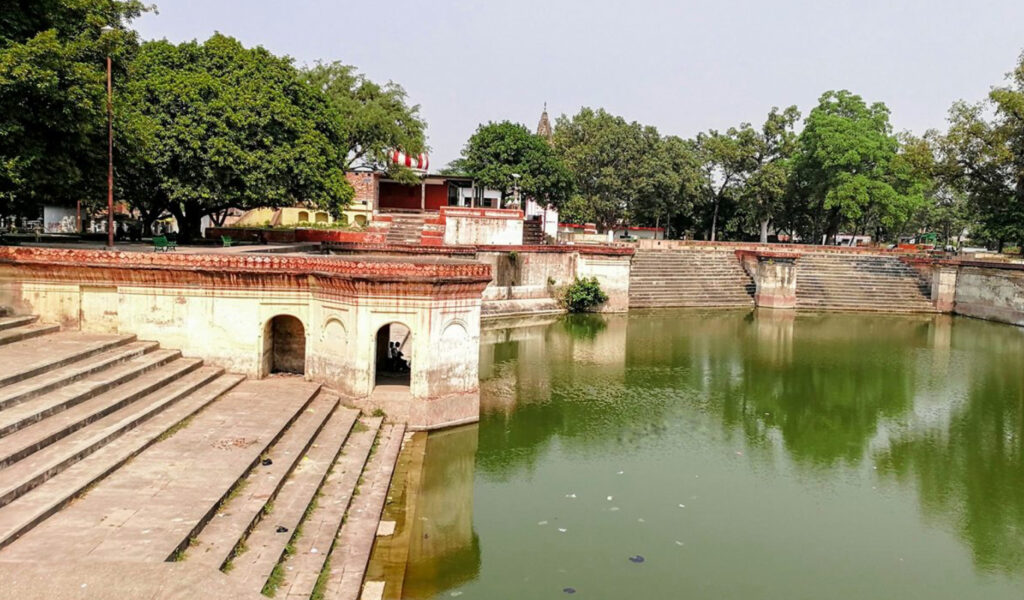
Surya Kund is one of the hidden spiritual gems of Ayodhya. Dedicated to the Sun God, this ancient stepwell-style pond is surrounded by temples and is used by pilgrims for ritual bathing and worship.
It’s a peaceful site with less crowd, making it perfect for spiritual seekers looking to avoid touristy chaos.
What to Expect:
- Traditional stone steps (kund) filled with holy water
- Small temples and shrines on the edges of the kund
- Peaceful surroundings, perfect for quiet meditation
Travel Tips:
- Carry your own water and essentials—facilities are limited
- Visit during daylight hours only
- Avoid visiting alone late evening as it’s quiet and less frequented
How to Reach:
- Approx. 4–5 km from Ayodhya city center
- Easily reachable via private vehicle or local auto
7. Nandigram: Where Bharat Waited for Ram
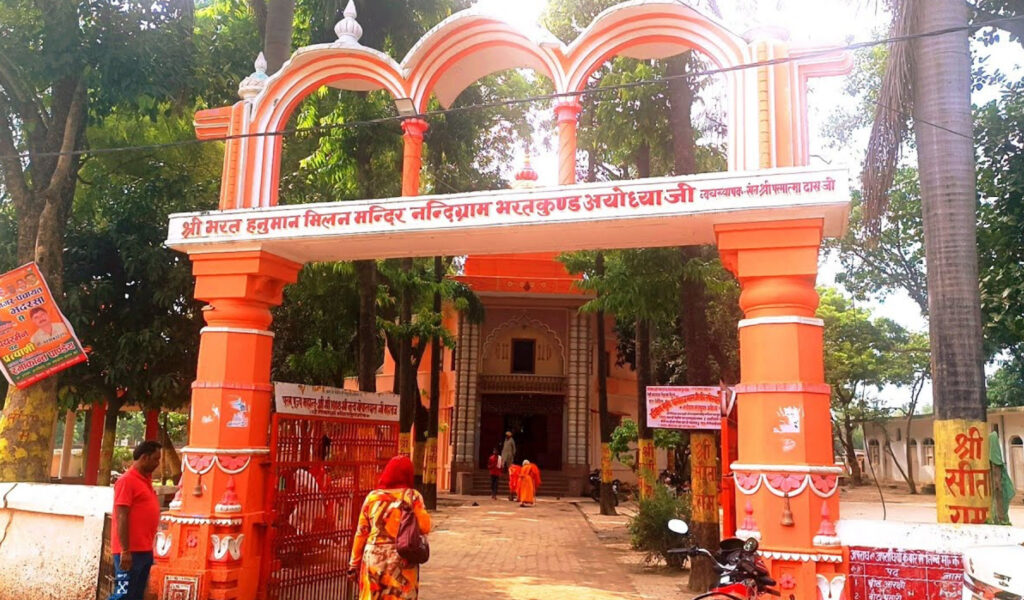
A peaceful village located about 15 km from Ayodhya, Nandigram is where Bharat ruled in exile, placing Lord Ram’s wooden slippers on the throne during his 14-year vanvaas. The site reflects deep devotion, sacrifice, and love between brothers, and is a meaningful stop among Ayodhya sightseeing places for those exploring the epic’s emotional depth.
The temple at Nandigram honors Bharat and his act of loyalty. Surrounded by greenery, this spot is calm, soul-stirring, and ideal for travelers wanting a deeper understanding of the Ramayan.
What to Expect:
- Simple temple architecture and calm village setting
- Historical storytelling by locals and priests
- Nearby forest areas perfect for quiet walks or reflection
Travel Tips:
- Best visited by cab or as part of a guided day trip
- Take snacks and water with you; limited options in the area
- Spend time soaking in the peaceful vibe
How to Reach:
- About 15 km from Ayodhya city
- Reachable by taxi, private cab, or city tour package
8. Bharat Kund: Sacred Waters of Devotion
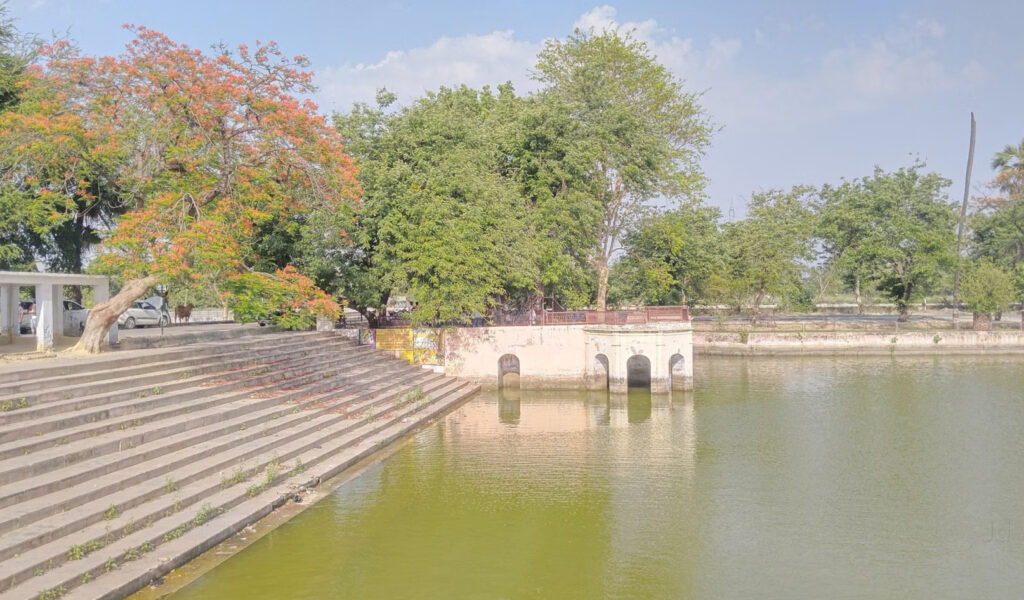
Close to Nandigram, Bharat Kund is the pond where Bharat performed rituals and prayers for Lord Ram during his exile. It is a small but powerful site, symbolizing devotion, patience, and brotherhood.
Travelers come here for its spiritual significance and peaceful natural surroundings.
What to Expect:
- A clean kund with steps for devotees to perform rituals
- Calm atmosphere with few visitors
- Local legends and Ramayan stories shared by temple priests
Travel Tips:
- Visit with a guide to fully understand its significance
- Ideal for meditative or reflective visits
- Wear modest, temple-appropriate clothing
How to Reach:
- Located near Nandigram, approx. 15 km from Ayodhya city
- Best reached via private car or as part of a tour
9. Swami Narayan Chapayia: Birthplace of a Saint
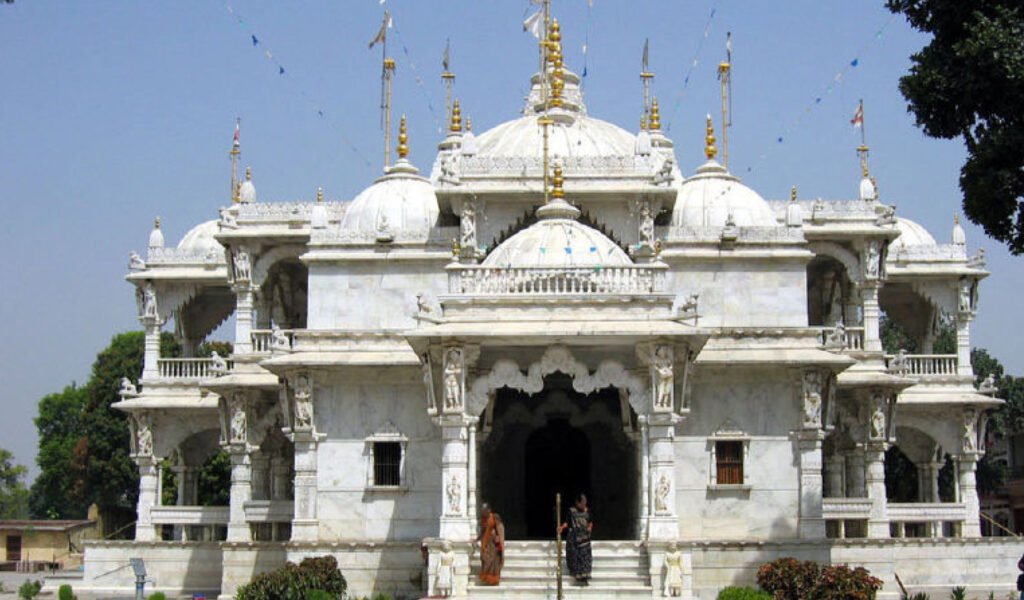
Located in Chhapaiya village, around 50 km from Ayodhya, Swami Narayan Chapayia is the birthplace of Lord Swaminarayan, the founder of the Swaminarayan sect. The temple complex is clean, spacious, and spiritually vibrant.
The temple’s calm setting and devotional energy make it a great stop for spiritual travelers and those exploring India’s religious diversity.
What to Expect:
- Clean and well-maintained temple premises
- Devotees from across India, especially Gujarat
- Peaceful gardens and temple halls with devotional songs playing
Travel Tips:
- Combine this with a half-day rural exploration or heritage walk
- Visit early to avoid afternoon heat
- Carry water and essentials for the road
How to Reach:
- Around 50 km from Ayodhya city
- Best reached by taxi or private vehicle
- Travel time: approx. 1.5 hours by road
10. Ramkatha Park: A Cultural Retreat by the Saryu
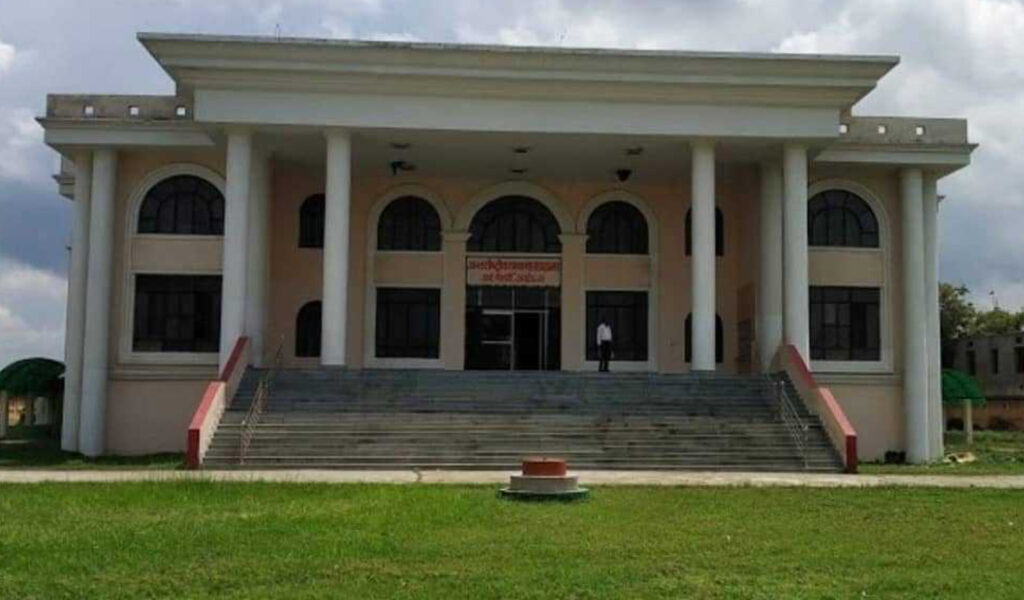
Ramkatha Park is a beautifully landscaped cultural and spiritual haven along the Saryu River, created to celebrate the story of Lord Ram. Unlike traditional temples, this park combines serene green spaces, interpretive installations, and live experiences—offering a modern and immersive way to explore the Ramayan era.
What to Expect:
- Scenic Walkways & Gardens: Nicely maintained lawns, fountains, and shaded pathways—perfect for relaxing strolls.
- Cultural Installations: Artistic depictions of scenes from the Ramayan—ideal for storytelling and photo opportunities.
- Ramleela & Spiritual Discourse: Regularly hosted open-air performances and audio-visual narrations that bring the epic tale to life.
- Evening Aarti & Music: Peaceful riverside aarti accompanied by devotional music and chants create a magical, soul-soothing atmosphere.
Travel Tips:
- Timings: The park is usually open late into the evening—check local hours especially during festivals.
- Comfort: Wear comfortable shoes for walking; shaded benches are available.
- Photo Ops: Low-lit but scenic—carry a phone or camera with decent low-light capabilities.
- Refreshments & Facilities: Basic stalls are available, but carry water with you.
- Best Time: Evenings or sunset hours are ideal for performances and that special riverside glow.
How to Reach Ramkatha Park:
By Train:
- About 2–3 km from Ayodhya Railway Station—easily accessible via auto-rickshaw or cycle rickshaw.
- Roughly 7–8 km from Faizabad Junction (Ayodhya Cantt).
By Air:
- Ayodhya International Airport is around 10–12 km away; taxis and cab services are readily available.
- Lucknow Airport is approx. 130 km away, with frequent road transport options to Ayodhya.
By Road:
- Well-connected via local buses, shared tempos, and private taxis.
- Ask drivers to drop you at “Ramkatha Park” or “Saryu Ghat Park.”
On Foot:
- If you’re visiting other riverside locations like Gupt Hari Ghat, it’s just a short walk from there.
Conclusion: Walk Through Faith, History & Heritage
Ayodhya is more than just the birthplace of Lord Ram—it’s a living museum of devotion, epic tales, royal legacy, and peaceful reflection. From the grand Sri Ram Janmbhoomi and hilltop Hanuman Garhi to the quiet charm of Gupt Hari Ghat and cultural elegance of Ramkatha Park, each place offers a unique window into India’s spiritual soul.
Whether you’re a pilgrim seeking blessings, a culture lover tracing Ramayan footsteps, or a traveler in search of serenity—these top Ayodhya sightseeing places promise a journey that touches both heart and soul.
So pack your bags, open your heart, and let Ayodhya reveal its timeless beauty—one temple, one ghat, one story at a time.
Not sure where to begin in Ayodhya? Take a virtual walkthrough of key spiritual spots before your trip.
Ayodhya City Tour
Ayodhya, the place where Lord Rama was born, is a pilgrimage for the Hindus. Beyond its religious importance, Ayodhya has a rich history, dating back thousands of years, with references to the city appearing in ancient scriptures. It has also seen a number of dynasties rule over it, from the Mauryas to the Guptas.
